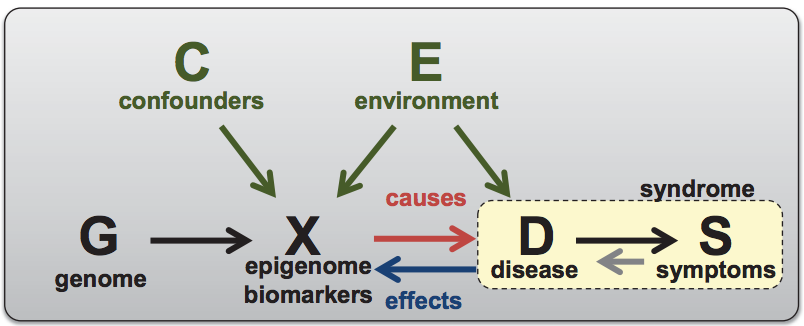33.2: Epidemiology- An Overview
- Page ID
- 41252

Commons license. For more information, see http://ocw.mit.edu/help/faq-fair-use/.
Figure 33.1: Factors that contribute to the probability of getting a disease. Each relationship shown represents correlation except for the link between genome and disease. Correlation does not mean causality, but we can use the genome to resolve causality.
Epidemiology is the study of patterns, causes, and effects of health and disease conditions in defined populations. In order to talk about epidemiology, we need to first understand some basic definitions and terms: Morbidity level is how sick an individual is whereas mortality is whether an individual is dead or not. The incidence is a rate which describes the number of new cases/people with a disease that appears during a period of time. The prevalence is the total steady state number of cases in the population. The attributable risk is the difference in rate of a disease between those exposed to the disease and those not exposed to the disease. Population burden refers to the years of potential life lost (YPLL), quality-adjusted or disability-adjusted life year (QALY/DALY). Syndrome refers to co-occurring signs or symptoms of a disease that are observed. The prevention challenge is to determine a disease and its cause and understand whether, when, and how to intervene.
In order to determine disease causes, studies must be designed according to certain principles of experimental design. These principles include control, randomization, replication, grouping, orthogonality, and combinatorics. Control groups are needed so that comparison to a baseline can be done.The placebo effect is real, so having a control group is necessary. The people who get the putative treatment being tested must also be random so that there is no bias. The study needs to be replicated as well in order to control for variability in the initial sample. (This is similar to the winners curse. Someone may win a race because they did outstanding in that particular round and surpassed their personal average, but in the next round they probably will regress back to performing close to their average.) Understanding variation between different subgroups may also play a large role in the outcomes of experiments. These may include subgroups based on age, gender, or demographics. One subgroup of the population may be contributing in a more profound way then they rest, so looking at each subgroup specifically is important. Orthogonality, or the combination of all factors and treatments, and combinatorics, factorial design, must also be taken into account when designing an experiment. With disease studies in particular, ethics when dealing with human subjects must be taken into account. There are legal and ethical constraints which are overseen by review boards. Clinical trials must be performed either blind (patient does not know if they are getting treatment or not) or double-blind (doctor also doesn't know). A patient who knows if they have gotten a treatment may change their habits causing bias, or a doctor who knows a patient got the treatment may treat them differently or analyze their results differently. Both considerations need to be taken into account to lower the bias that may cause different results of a clinical trial.
Example An example of the need for a randomized control trial is the treatment of ebola. A treatment must be distributed randomly to individuals being treated in different hospitals and it must be blind. If someone believes they are getting the vaccine, they may alter their habits to protect themselves which may affect the outcome. If only patients of one hospital get the vaccine, there is a possibility that the effects seen are just from that hospital being more careful.
FAQ
Q: In poorly designed experiments, is there one aspect that is most commonly overlooked?
A: The most commonly missed is subgroup structure. It is sometimes not obvious what the different subgroups could be. To help with this, researchers can look at general properties of a predictor by trying to cluster cases and controls independently and visualize the clustering. If there is substructure other than case/control in the clustering, researchers can look for variables within each cluster to see what is driving substructure.

